Paul Thompson
West Group
Distributed Harmonization: Federated Clustered Batch Effect Adjustment and Generalization
May 23, 2024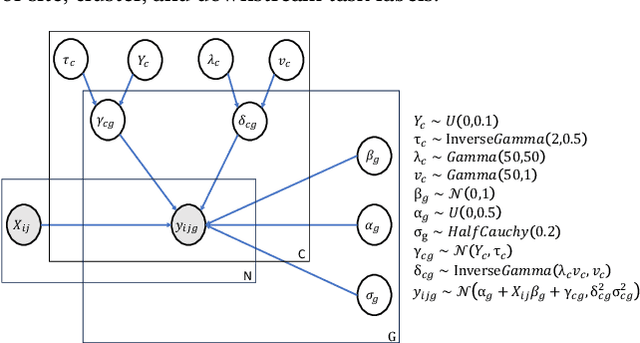

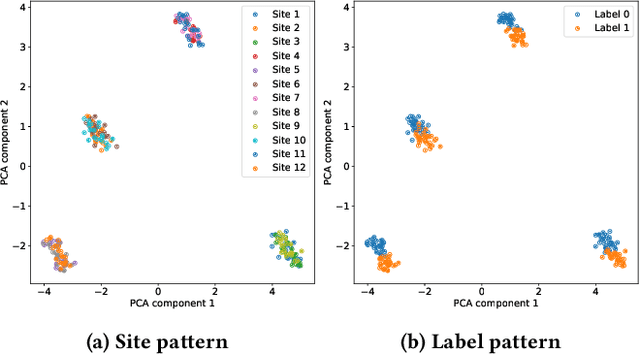

Abstract:Independent and identically distributed (i.i.d.) data is essential to many data analysis and modeling techniques. In the medical domain, collecting data from multiple sites or institutions is a common strategy that guarantees sufficient clinical diversity, determined by the decentralized nature of medical data. However, data from various sites are easily biased by the local environment or facilities, thereby violating the i.i.d. rule. A common strategy is to harmonize the site bias while retaining important biological information. The ComBat is among the most popular harmonization approaches and has recently been extended to handle distributed sites. However, when faced with situations involving newly joined sites in training or evaluating data from unknown/unseen sites, ComBat lacks compatibility and requires retraining with data from all the sites. The retraining leads to significant computational and logistic overhead that is usually prohibitive. In this work, we develop a novel Cluster ComBat harmonization algorithm, which leverages cluster patterns of the data in different sites and greatly advances the usability of ComBat harmonization. We use extensive simulation and real medical imaging data from ADNI to demonstrate the superiority of the proposed approach.
Interpretable Spatio-Temporal Embedding for Brain Structural-Effective Network with Ordinary Differential Equation
May 21, 2024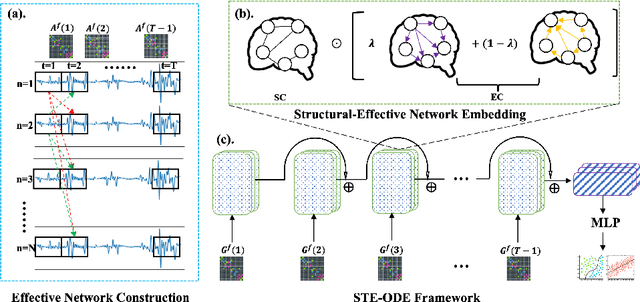
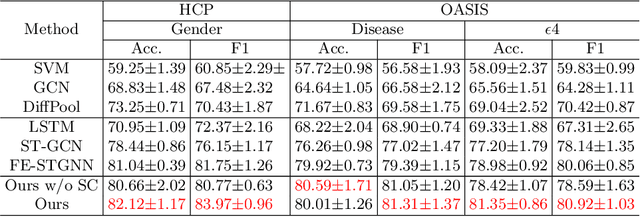
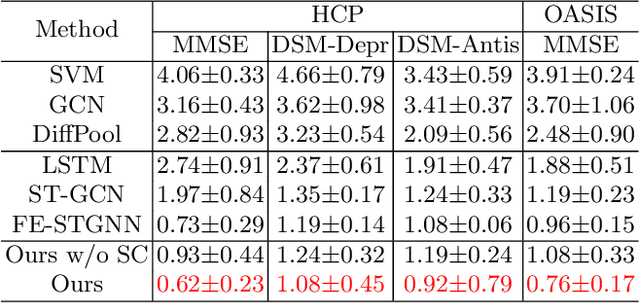
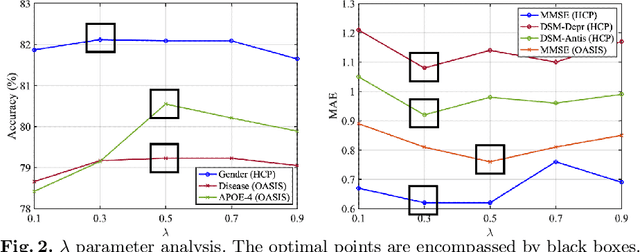
Abstract:The MRI-derived brain network serves as a pivotal instrument in elucidating both the structural and functional aspects of the brain, encompassing the ramifications of diseases and developmental processes. However, prevailing methodologies, often focusing on synchronous BOLD signals from functional MRI (fMRI), may not capture directional influences among brain regions and rarely tackle temporal functional dynamics. In this study, we first construct the brain-effective network via the dynamic causal model. Subsequently, we introduce an interpretable graph learning framework termed Spatio-Temporal Embedding ODE (STE-ODE). This framework incorporates specifically designed directed node embedding layers, aiming at capturing the dynamic interplay between structural and effective networks via an ordinary differential equation (ODE) model, which characterizes spatial-temporal brain dynamics. Our framework is validated on several clinical phenotype prediction tasks using two independent publicly available datasets (HCP and OASIS). The experimental results clearly demonstrate the advantages of our model compared to several state-of-the-art methods.
ConspEmoLLM: Conspiracy Theory Detection Using an Emotion-Based Large Language Model
Mar 11, 2024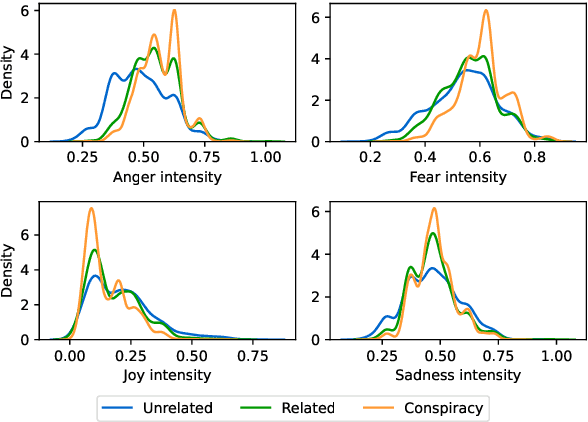
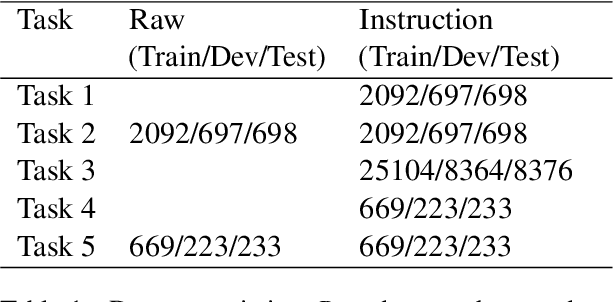
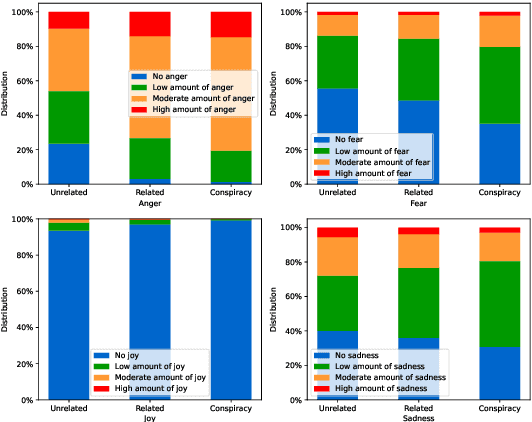
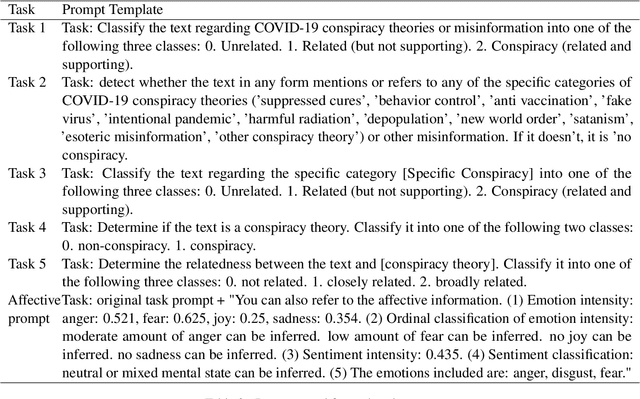
Abstract:The internet has brought both benefits and harms to society. A prime example of the latter is misinformation, including conspiracy theories, which flood the web. Recent advances in natural language processing, particularly the emergence of large language models (LLMs), have improved the prospects of accurate misinformation detection. However, most LLM-based approaches to conspiracy theory detection focus only on binary classification and fail to account for the important relationship between misinformation and affective features (i.e., sentiment and emotions). Driven by a comprehensive analysis of conspiracy text that reveals its distinctive affective features, we propose ConspEmoLLM, the first open-source LLM that integrates affective information and is able to perform diverse tasks relating to conspiracy theories. These tasks include not only conspiracy theory detection, but also classification of theory type and detection of related discussion (e.g., opinions towards theories). ConspEmoLLM is fine-tuned based on an emotion-oriented LLM using our novel ConDID dataset, which includes five tasks to support LLM instruction tuning and evaluation. We demonstrate that when applied to these tasks, ConspEmoLLM largely outperforms several open-source general domain LLMs and ChatGPT, as well as an LLM that has been fine-tuned using ConDID, but which does not use affective features. This project will be released on https://github.com/lzw108/ConspEmoLLM/.
Emotion Detection for Misinformation: A Review
Nov 01, 2023
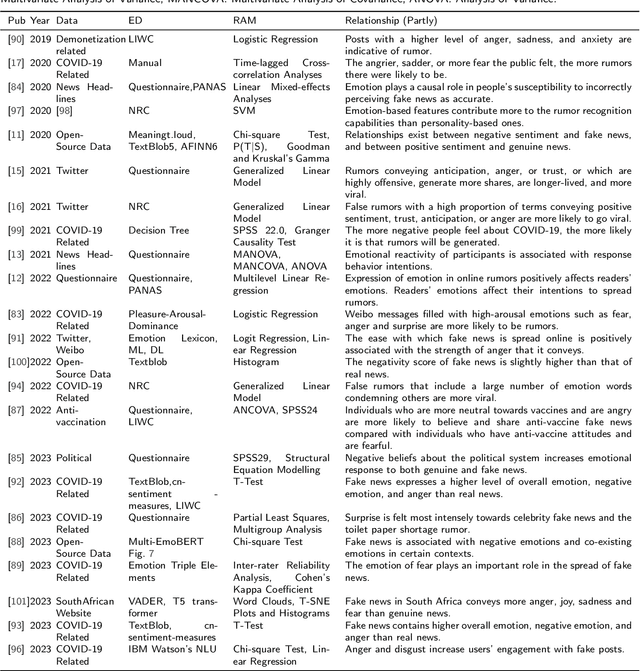
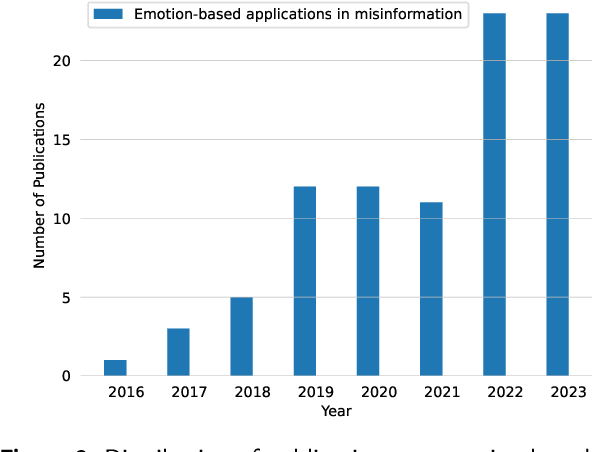
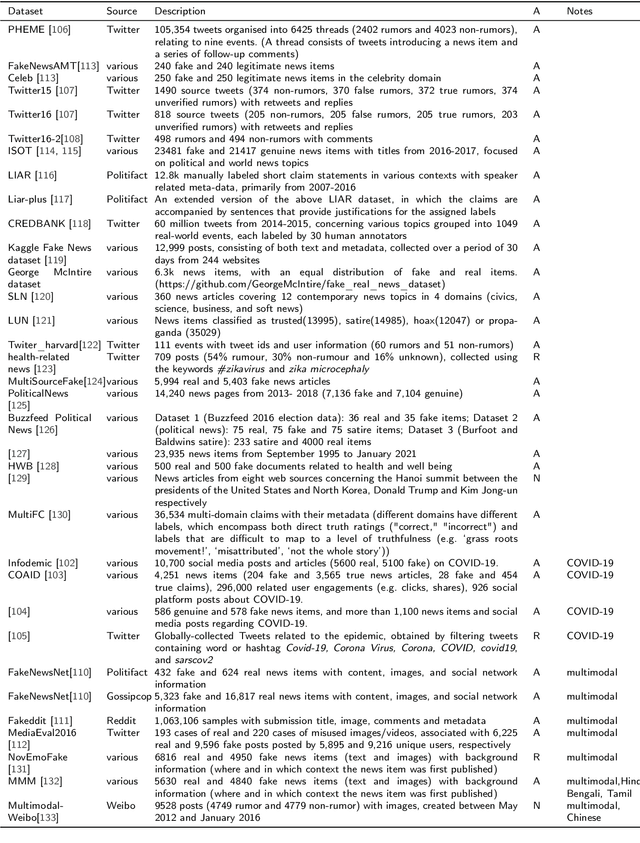
Abstract:With the advent of social media, an increasing number of netizens are sharing and reading posts and news online. However, the huge volumes of misinformation (e.g., fake news and rumors) that flood the internet can adversely affect people's lives, and have resulted in the emergence of rumor and fake news detection as a hot research topic. The emotions and sentiments of netizens, as expressed in social media posts and news, constitute important factors that can help to distinguish fake news from genuine news and to understand the spread of rumors. This article comprehensively reviews emotion-based methods for misinformation detection. We begin by explaining the strong links between emotions and misinformation. We subsequently provide a detailed analysis of a range of misinformation detection methods that employ a variety of emotion, sentiment and stance-based features, and describe their strengths and weaknesses. Finally, we discuss a number of ongoing challenges in emotion-based misinformation detection based on large language models and suggest future research directions, including data collection (multi-platform, multilingual), annotation, benchmark, multimodality, and interpretability.
Towards Sparsified Federated Neuroimaging Models via Weight Pruning
Aug 24, 2022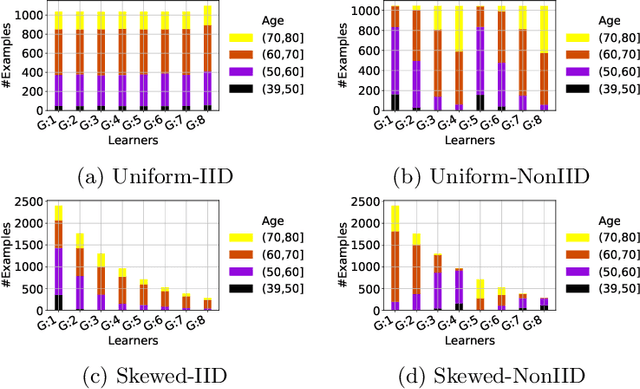

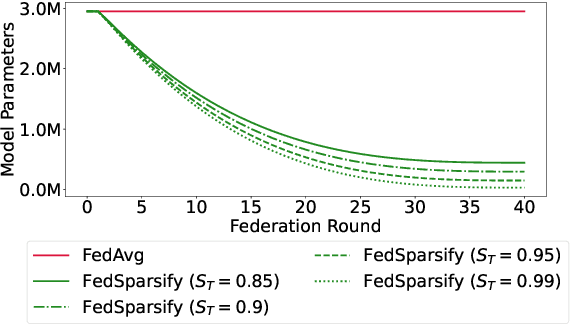
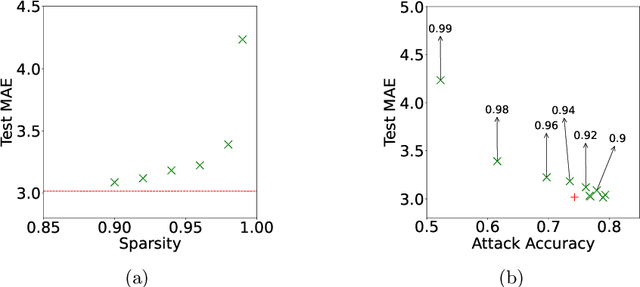
Abstract:Federated training of large deep neural networks can often be restrictive due to the increasing costs of communicating the updates with increasing model sizes. Various model pruning techniques have been designed in centralized settings to reduce inference times. Combining centralized pruning techniques with federated training seems intuitive for reducing communication costs -- by pruning the model parameters right before the communication step. Moreover, such a progressive model pruning approach during training can also reduce training times/costs. To this end, we propose FedSparsify, which performs model pruning during federated training. In our experiments in centralized and federated settings on the brain age prediction task (estimating a person's age from their brain MRI), we demonstrate that models can be pruned up to 95% sparsity without affecting performance even in challenging federated learning environments with highly heterogeneous data distributions. One surprising benefit of model pruning is improved model privacy. We demonstrate that models with high sparsity are less susceptible to membership inference attacks, a type of privacy attack.
Functional2Structural: Cross-Modality Brain Networks Representation Learning
May 06, 2022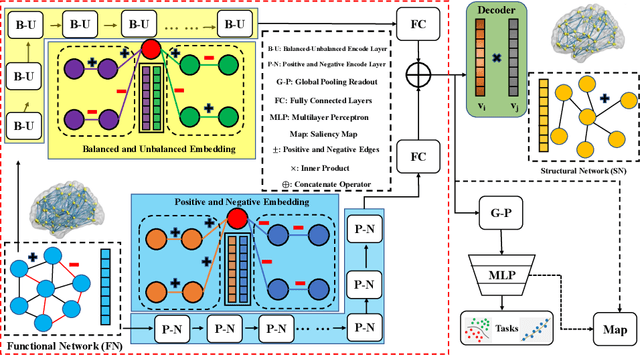
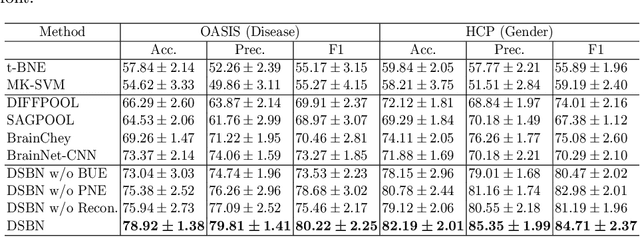

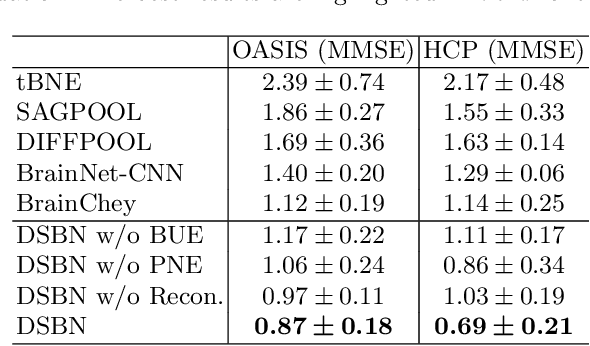
Abstract:MRI-based modeling of brain networks has been widely used to understand functional and structural interactions and connections among brain regions, and factors that affect them, such as brain development and disease. Graph mining on brain networks may facilitate the discovery of novel biomarkers for clinical phenotypes and neurodegenerative diseases. Since brain networks derived from functional and structural MRI describe the brain topology from different perspectives, exploring a representation that combines these cross-modality brain networks is non-trivial. Most current studies aim to extract a fused representation of the two types of brain network by projecting the structural network to the functional counterpart. Since the functional network is dynamic and the structural network is static, mapping a static object to a dynamic object is suboptimal. However, mapping in the opposite direction is not feasible due to the non-negativity requirement of current graph learning techniques. Here, we propose a novel graph learning framework, known as Deep Signed Brain Networks (DSBN), with a signed graph encoder that, from an opposite perspective, learns the cross-modality representations by projecting the functional network to the structural counterpart. We validate our framework on clinical phenotype and neurodegenerative disease prediction tasks using two independent, publicly available datasets (HCP and OASIS). The experimental results clearly demonstrate the advantages of our model compared to several state-of-the-art methods.
HSEarch: semantic search system for workplace accident reports
Mar 23, 2021



Abstract:Semantic search engines, which integrate the output of text mining (TM) methods, can significantly increase the ease and efficiency of finding relevant documents and locating important information within them. We present a novel search engine for the construction industry, HSEarch (http://www.nactem.ac.uk/hse/), which uses TM methods to provide semantically-enhanced, faceted search over a repository of workplace accident reports. Compared to previous TM-driven search engines for the construction industry, HSEarch provides a more interactive means for users to explore the contents of the repository, to review documents more systematically and to locate relevant knowledge within them.
Scaling Neuroscience Research using Federated Learning
Feb 16, 2021



Abstract:The amount of biomedical data continues to grow rapidly. However, the ability to analyze these data is limited due to privacy and regulatory concerns. Machine learning approaches that require data to be copied to a single location are hampered by the challenges of data sharing. Federated Learning is a promising approach to learn a joint model over data silos. This architecture does not share any subject data across sites, only aggregated parameters, often in encrypted environments, thus satisfying privacy and regulatory requirements. Here, we describe our Federated Learning architecture and training policies. We demonstrate our approach on a brain age prediction model on structural MRI scans distributed across multiple sites with diverse amounts of data and subject (age) distributions. In these heterogeneous environments, our Semi-Synchronous protocol provides faster convergence.
Deep Representation Learning For Multimodal Brain Networks
Jul 19, 2020



Abstract:Applying network science approaches to investigate the functions and anatomy of the human brain is prevalent in modern medical imaging analysis. Due to the complex network topology, for an individual brain, mining a discriminative network representation from the multimodal brain networks is non-trivial. The recent success of deep learning techniques on graph-structured data suggests a new way to model the non-linear cross-modality relationship. However, current deep brain network methods either ignore the intrinsic graph topology or require a network basis shared within a group. To address these challenges, we propose a novel end-to-end deep graph representation learning (Deep Multimodal Brain Networks - DMBN) to fuse multimodal brain networks. Specifically, we decipher the cross-modality relationship through a graph encoding and decoding process. The higher-order network mappings from brain structural networks to functional networks are learned in the node domain. The learned network representation is a set of node features that are informative to induce brain saliency maps in a supervised manner. We test our framework in both synthetic and real image data. The experimental results show the superiority of the proposed method over some other state-of-the-art deep brain network models.
Large-Scale Unsupervised Deep Representation Learning for Brain Structure
May 02, 2018



Abstract:Machine Learning (ML) is increasingly being used for computer aided diagnosis of brain related disorders based on structural magnetic resonance imaging (MRI) data. Most of such work employs biologically and medically meaningful hand-crafted features calculated from different regions of the brain. The construction of such highly specialized features requires a considerable amount of time, manual oversight and careful quality control to ensure the absence of errors in the computational process. Recent advances in Deep Representation Learning have shown great promise in extracting highly non-linear and information-rich features from data. In this paper, we present a novel large-scale deep unsupervised approach to learn generic feature representations of structural brain MRI scans, which requires no specialized domain knowledge or manual intervention. Our method produces low-dimensional representations of brain structure, which can be used to reconstruct brain images with very low error and exhibit performance comparable to FreeSurfer features on various classification tasks.
 Add to Chrome
Add to Chrome Add to Firefox
Add to Firefox Add to Edge
Add to Edge